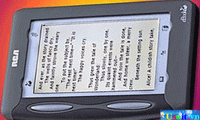Login form
E-Book
 E-Book, fiction or nonfiction text that is distributed and read in digital form, usually on a computer or handheld display device. Because they can be cheaply distributed worldwide over the Internet and do not require shelf space, e-books have the potential to someday replace the printed book. Devices that store and display electronic texts are sometimes referred to generically as e-books.
E-Book, fiction or nonfiction text that is distributed and read in digital form, usually on a computer or handheld display device. Because they can be cheaply distributed worldwide over the Internet and do not require shelf space, e-books have the potential to someday replace the printed book. Devices that store and display electronic texts are sometimes referred to generically as e-books.
E-book texts are downloaded to a computer or a reading device through a modem or other Internet connection. Some devices cannot download texts and must be connected to another computer in order to transfer the book to its memory.
Once a book is downloaded, the computer or e-book device uses special software to display the text for reading. Most e-book devices run on batteries so they can be taken anywhere, like a printed book. The text is displayed on a backlit screen for easier reading. Controls allow the reader to scroll up and down and to move forward and back in the text. Depending on battery technology and screen features, some devices can provide 40 or more hours of reading time before recharging.
E-books and e-book devices have several advantages over traditional printed books.
E-book devices can hold the texts of many different books at one time, making them popular with students or professionals who have to carry or consult many reference materials, technical manuals, or textbooks. Many devices also allow the reader to select from various type sizes, search the text, switch quickly between books, and access stored reference works to look up unfamiliar words or concepts. Because they lack the high costs of printing and distribution, e-books also have the potential to yield greater profits for publishers and authors. In addition, more and more first-time authors or those who write on lesser-known topics have turned to e-books to get their books published.
E-books also have potential disadvantages, some of which might be addressed as technology improves. These include the cost of the computer or e-book device, consumer resistance to reading on electronic screens, and uncertainty about the business model. Concerns about pricing, royalties, illegal copying of texts, and the lack of a single software standard for publishing e-books have slowed the rollout of e-books by major publishing companies.
Despite these issues, bestselling fiction writer Stephen King self-published a novella titled Riding the Bullet as an e-book in March 2000. The work became the first successful mass-market release of an e-book, generating more than 400,000 downloads at a suggested price of $2.50 per copy. However, another e-book experiment by King later in the year—a serialization of a novel called The Plant—was not as successful, in part because a voluntary payment system did not produce enough paying customers. With the advent of e-books, some experts felt that top authors would no longer need a publishing company to market and sell their work.
The first conceptual design for an e-book device was produced in 1945, when computers were just being developed. In the early 1970s an effort known as Project Gutenberg was launched to create computerized copies of important texts, such as the Declaration of Independence and the plays of William Shakespeare. The Sony Corporation developed a device to read books from CD-ROMs in the early 1990s, but the product failed to catch on. With the spread of the World Wide Web a few years later, more electronic texts became available on the Internet. In 1998 the first handheld e-book devices were manufactured and marketed. These devices cost $300 to $500 and were capable of storing up to 10,000 pages of text. The costs and capabilities of the devices were expected to change with technological advances.

